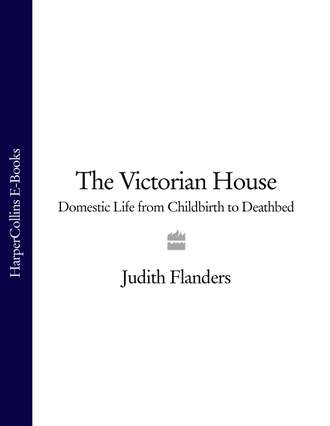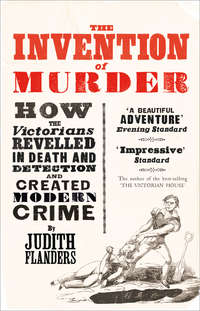
Полная версия
The Victorian House: Domestic Life from Childbirth to Deathbed
This style of advertising caught on, moving from rag-and-bone men to other working-class environments, such as fried-fish shops and stalls that produced cheaply prepared foods – stewed eels, baked potatoes – and finally soap companies (see pp. 119–21).
Kitchen waste, was, of course, the main item to be disposed of regularly, and advice books were full of information on what could be got rid of, in what way. It is difficult to know how far their precepts were followed – the stress laid on the immorality of straightforward disposal implies that probably many people threw out much more than they were expected to. Cooks who were not thrifty put all the kitchen leavings into a bucket. The content was called ‘wash’, and the washman visited regularly to buy it: he then sold it as ‘hog-wash’, or pigswill. Employers were warned solemnly about the evils of this system. First, it gave servants no incentive to reuse food. Some might even be encouraged to dishonesty: by telling an inexperienced housewife that she had to pay the washman to take the wash away, the cook could pocket money from both the wife and the washman.
The buckets waiting for collection also encouraged vermin, but this was hard to avoid: the local need for wash was high. Even late in the century, pigs were kept by working-class families in cities to provide a little extra income. Shepherds Bush in London ‘might perhaps be termed the pigsty of the metropolis; for here every house has its piggery, and the air is sonorous with the grunting of porkers’.64 Henry Mayhew reported that Jacob’s Island, south of the Thames, near Bermondsey, had houses built out on stilts over the river: ‘At the back of every house that boasted a square foot or two of outlet … were pig-sties.’65 It was hard for the thrifty cook to see why what was to her waste should not be usefully disposed of.
Instead, a great deal of time was spent in suggesting ways to avoid the creation of wash. Many of these are procedures that are still accepted today, though followed by only the most conscientious and regular of cooks: fish heads were used to make fish soup; vegetables and the water they were cooked in went to make soup or gravy, as did plate scrapings and wine; stale bread was used for breadcrumbs, and for puddings. Anything that survived these operations was then fed to the dogs, cats or chickens. Tea leaves were rinsed and scattered over carpets to aid in collecting dust when sweeping, then they were burned in the range; cold tea was used to clean windows, or as a tonic for the eyes; mutton and veal fat could be clarified and used for frying.
Concern about hygiene always went hand in hand with food. Early in the century, meat mostly came from the city it was purchased in: even if the animals were driven to market there, they were butchered only on arrival, so beef, mutton and pork were relatively fresh when bought. With the rapid expansion of the railways, by mid-century animals as far away as Scotland were slaughtered for the London markets: Aberdeen, noted one journal, was ‘little else than a London abattoir’. More than half a million rabbits were shipped from Ostend to London alone; plovers came from Ireland, quail from Egypt. Seventy-five million eggs were imported every year from Europe.66
Before refrigeration, the best that could be managed at home was (rarely) a cool cellar or a tiled room on a north-facing wall: neither was ideal, but when meat was butchered locally, probably only the day before it was purchased, this was not too serious. As the distances grew, so did the amount of time food had to stay fresh. Likewise, local dairies were preferred to milk that arrived by train, but this too became more and more difficult to avoid.
Much advice was given to housewives on how to ensure that the food they had bought was good, and how to prolong its life in that condition.67 Meat needed to be examined regularly, and powdering it with ginger or pepper against flies was recommended. Charcoal kept meat fresh, and also removed the taint from already putrescent meat. Scalded milk stayed drinkable for several hours longer than fresh. To keep it for several days, grated horseradish added to the jug would help, ‘even in hot weather’. Boiled and then packed in sawdust, eggs would keep fresh for up to three months, or they could be covered in flax-seed oil, to keep for six months. Even with these tips, menus still had to be changed with the weather. Jane Brookfield, the wife of the curate of St James’s Church, Piccadilly, wrote to her husband when she was away, ‘the Salmon from Exeter and the green-pea soup and the chickens and jellies have to be eaten at an early dinner to-day … the hot weather not permitting any delays’.68 And, despite preventatives and precautions, Marion Sambourne’s diaries are filled with entries that say ‘Bad fowl’, ‘Bad mutton at lunch’, ‘Very late dinner, duck bad, had to send out for lobster & steak.’69
Preventative measures were laborious, but could not be ignored. If butter was bought in quantity, by the tub, ‘the first thing to be done is to turn the whole of the butter out, and, with a clean knife, to scrape the outside; the tub should then be wiped with a clean cloth, and sprinkled all round with salt, the butter replaced, and the lid kept on to exclude the air. It is necessary to take these precautions, as sometimes a want of proper cleanliness in the dairymaid causes the outside of the butter to become rancid.’
Bread was known to be filthy. A parliamentary report in 1862 had suggested that ‘the principal fact’ about bakeries
was their extreme dirt, and in many places the almost total covering of the entire space between the rafters with masses of cobwebs, weighed down with the flour dust that had accumulated upon them, and hanging in strips just above your head. A heavy tread or a blow upon the floor above, brought down large fragments of them, as I witnessed on more than one occasion; and as the rafters immediately over the troughs in which the dough is made are as thickly hung with them as any other part of the bakehouse, masses of these cobwebs must be frequently falling into the dough …
Animals in considerable numbers crawled in and out of and upon the troughs where the bread was made, and upon the adjoining walls …
In addition the ‘air of those small bakehouses is generally overloaded with foul gases from the drains, from the ovens, and from the fermentation of the bread, and with the emanations from [the bakers’] own bodies’.70 After this description it seems natural that a completely machine-mixed, yeastless bread was soon created: the Aerated Bread Company produced this sanitary product, and sold it in their own Aerated Bread Company tea shops. (The ABCs, as they become known, were among the first tea shops that respectable ladies could patronize without a male escort, and they survived well into the second half of the twentieth century.)
Even something as apparently straightforward as watercress was dangerous. Little girls sold it on the street, and door to door, but everyone knew that London cress came mostly from Camden Town, where the ‘beds are planted in an old brick-field, watered by the Fleet Ditch; and though the stream at this point is comparatively pure,* they owe their unusually luxuriant appearances to a certain admixture of the sewerage’.71 There was even a publication, Water-Cresses without Sewage (1878), which told how to grow your own, to avoid cress grown in sewage and very likely bearing typhus.72
For, however worrying dirt was, what it really betokened was disease. ‘Drains’ was the shorthand used by all to indicate water-borne illness. Mid-century, when the miasma theory of disease transmission was popular, the smell from drains was thought to bring illnesses; later, with germ theory, gradually the understanding that it was the water itself was disseminated. Whatever the case, drains were trouble. In a Sherlock Holmes story two houses have remained empty for some time ‘on account of him that owns them, who won’t have the drains seed to, though the very last tenant what lived in one of them died o’ typhoid fever’.73 Professionals made the same association. The Plumber warned, ‘There are a “thousand gates to death!” Few are wider, or open more readily, than those in our own homes’ – the drains.74 After all, the linking of houses to a communal sewer was a new concept. For the first part of the century, people had continued much as they had before, with cesspools beneath their houses. And as late as 1888 Mrs Haweis was still writing, ‘between you and me, the old cesspool, if properly emptied and deodorized
Конец ознакомительного фрагмента.
Текст предоставлен ООО «ЛитРес».
Прочитайте эту книгу целиком, купив полную легальную версию на ЛитРес.
Безопасно оплатить книгу можно банковской картой Visa, MasterCard, Maestro, со счета мобильного телефона, с платежного терминала, в салоне МТС или Связной, через PayPal, WebMoney, Яндекс.Деньги, QIWI Кошелек, бонусными картами или другим удобным Вам способом.




